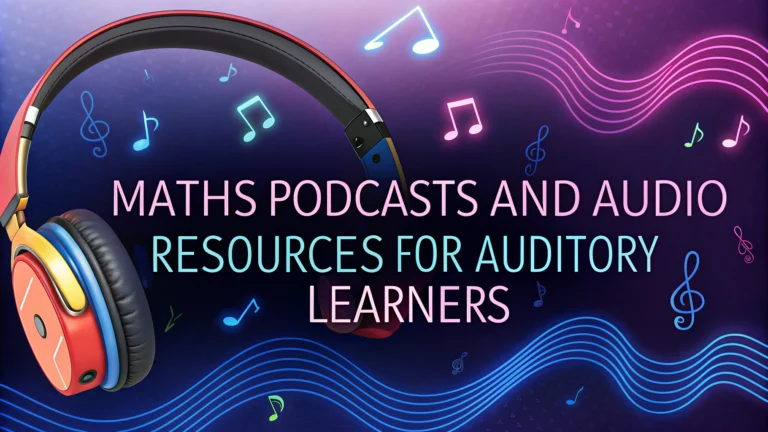Math doesn’t have to be a visual-only subject. For auditory learners, podcasts and audio resources can be game-changers. This guide explores how to harness these tools for effective math learning.
We’ll cover top math podcasts, audio textbooks, and innovative ways to use sound for problem-solving. Whether you’re a student, parent, or educator, you’ll find practical tips to boost math skills through listening.
Benefits of Audio Resources for Math Learning
Auditory learning can complement traditional math education methods. It offers:
- Improved understanding of complex concepts
- Enhanced retention through repetition
- Flexibility to learn on-the-go
- Reduced screen time
These benefits make audio resources valuable tools for students of all ages. They’re especially helpful for those who struggle with visual learning or have reading difficulties.
Top Math Podcasts for Different Age Groups
Here’s a curated list of math podcasts tailored for various age groups:
| Age Group | Podcast Name | Focus Area |
|---|---|---|
| 6-10 | Bedtime Math | Fun math stories and problems |
| 11-14 | Math Mutation | Interesting math concepts |
| 15-18 | Breaking Math | Advanced topics and applications |
These podcasts offer engaging content that makes math more accessible and enjoyable. They cover a range of topics from basic arithmetic to advanced calculus.
Innovative Audio Tools for Math Problem-Solving
Audio tools can transform how students approach math problems. Some effective options include:
- Math narration apps
- Voice-activated calculators
- Audio graphing tools
These tools help students visualize problems mentally and develop stronger problem-solving skills. They’re particularly useful for learners with visual impairments or processing difficulties.
Unlocking the Power of Audio Learning in Mathematics
Math doesn’t have to be a visual-only subject. Audio resources can transform how students learn and solve problems. This guide explores practical ways to use podcasts, audio tools, and innovative techniques to boost math skills through listening.
Benefits of Audio Resources for Math Learning
Audio learning complements traditional math education by offering:
- Improved understanding of complex concepts
- Enhanced retention through repetition
- Flexibility to learn on-the-go
- Reduced screen time
These benefits make audio resources valuable for students of all ages, especially those who struggle with visual learning or have reading difficulties.
Top Math Podcasts for Different Age Groups
Here’s a curated list of math podcasts tailored for various age groups:
| Age Group | Podcast Name | Focus Area |
|---|---|---|
| 6-10 | Bedtime Math | Fun math stories and problems |
| 11-14 | Math Mutation | Interesting math concepts |
| 15-18 | Breaking Math | Advanced topics and applications |
Innovative Audio Tools for Math Problem-Solving
Audio tools can transform how students approach math problems. Some effective options include:
- Math narration apps
- Voice-activated calculators
- Audio graphing tools
These tools help students visualize problems mentally and develop stronger problem-solving skills. They’re particularly useful for learners with visual impairments or processing difficulties.
Incorporating Audio Learning into Daily Math Practice
Integrating audio resources into daily math routines can significantly enhance learning. Here are some practical tips:
- Listen to math podcasts during commutes or downtime
- Use audio textbooks for review before exams
- Practice mental math with audio quizzes
- Record and playback problem-solving steps
Consistency is key. Aim for at least 15-20 minutes of audio math learning daily for optimal results.
Addressing Common Challenges in Audio Math Learning
While audio resources offer many benefits, they can present challenges. Here’s how to overcome them:
- Difficulty visualizing: Use mental imagery techniques or pair audio with simple diagrams
- Maintaining focus: Choose engaging podcasts and use active listening strategies
- Complex equations: Break down equations into smaller parts and use mnemonic devices
Remember, audio learning is a skill that improves with practice. Be patient and persistent in your approach.
Combining Audio and Visual Learning for Maximum Impact
While audio resources are powerful, combining them with visual elements can enhance learning even further. Try these strategies:
- Use audio explanations alongside written problems
- Create mind maps while listening to math concepts
- Pair audio lessons with hands-on manipulatives
- Alternate between audio and visual learning methods
This multi-sensory approach caters to different learning styles and reinforces understanding from multiple angles.
Measuring Progress and Adjusting Your Audio Learning Strategy
To ensure your audio math learning is effective, regularly assess your progress:
- Take practice tests after audio study sessions
- Keep a learning journal to track comprehension
- Discuss concepts learned through audio with peers or teachers
- Adjust your audio resource selection based on performance
Be open to trying different audio resources and methods until you find what works best for you.
Embracing the Future of Math Education Through Audio
Audio learning in mathematics is more than just a trend. It’s a valuable tool that can make math more accessible, engaging, and effective for learners of all ages and abilities.
By incorporating audio resources into your math learning routine, you can unlock new ways of understanding complex concepts, improve retention, and develop stronger problem-solving skills. Start exploring the world of audio math learning today and discover how it can transform your mathematical journey.

